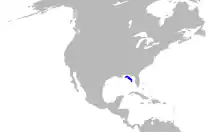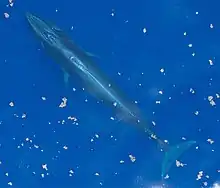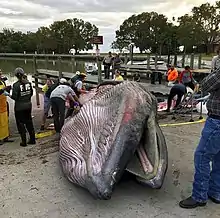Rice's whale
Rice's whale (Balaenoptera ricei) is a species of baleen whale endemic to the northeastern regions of the Gulf of Mexico. It was historically identified as a subspecies of the Bryde's whale and known as the Gulf of Mexico Bryde's whale.[2] Its distinction from this species was first detected in 2014 by two geneticists, who found mitochondrial and nuclear DNA evidence indicating the gulf population was a distinct evolutionary lineage and a possible new species most closely related to the Eden's whale.[3] Additional genetic and anatomical evidence published in a 2021 follow-up study confirmed this status. The common name and specific epithet was named in honor of the late cetologist Dale W. Rice.[4][2]
| Rice's whale | |
|---|---|
 | |
| Rice's whale in the Gulf of Mexico | |
 | |
| Size compared to an average human | |
| Scientific classification | |
| Kingdom: | Animalia |
| Phylum: | Chordata |
| Class: | Mammalia |
| Order: | Artiodactyla |
| Infraorder: | Cetacea |
| Family: | Balaenopteridae |
| Genus: | Balaenoptera |
| Species: | B. ricei |
| Binomial name | |
| Balaenoptera ricei Rosel et al., 2021 | |
 | |
| Core range as of June 2019 | |
| Synonyms | |
| |
Description and behavior

It is an intermediate-sized rorqual, reaching up to 12.65 meters (41.5 ft) in length.[5] This would correspond to a weight of around 13.87 metric tons (13.65 long tons; 15.29 short tons) through a length-weight function developed by Ohsumi (1980).[5][6] Little is known about their ecology, and hypotheses on their diet and behavior are largely inferred from the Bryde's whales'. Rice's whales are typically sighted alone or in pairs, but they occasionally form large loose groups believed to be associated with feeding.[5][7] Rice's whale make daytime foraging dives as deep as 271 m (889 ft), while at night they typically stay within 15 m (49 ft) of the surface, occasionally making deeper dives of 150 m (490 ft).[8]
Distribution and habitat
Although some scientists believe that it may have historically inhabited the entire Gulf of Mexico, the species is now consistently sighted only within a small stretch of the gulf's northeastern section characterized by a continental shelf between 100 meters (330 ft) to 400 meters (1,300 ft) deep, where they remain year-round. There is a possibility that some populations may exist in Cuban and Mexican waters (hence why the current population estimate is only "fewer than 100" even though only 33–44 individuals are known from US waters), but currently the only population is known from the US. They are the only resident baleen whales known from the Gulf of Mexico, with most other species in the area being migratory.[7][9]
Phylogeny
The following cladogram is modified from a phylogenetic analysis by Rosel et al. (2021) based on genetic data.[2]
| Mysticeti |
| ||||||||||||||||||||||||||||||||||||||||||||||||||||||
Discovery
This species has been documented by whalers in the Gulf of Mexico since 1790,[10] and its now-small distribution was first noticed in the 1990s.[9] In 2014, a genetic study found Rice's whale to likely represent a distinct species or subspecies of whale.[3] The description of the species had been hampered by the lack of a good study specimen until early 2018, when a beached individual was found in Everglades National Park in Florida, which was later transported to the Smithsonian. This allowed a specimen of the species to be kept without having to kill or harm any of the individuals in the already-endangered population, and allowed for taxonomic studies to confirm its distinctiveness.[11]
Conservation status

Prior to its formal description as a distinct species, the Rice's whale was separately assessed by the IUCN red list as "Gulf of Mexico whale", and is listed as critically endangered. It is also listed as an endangered species by the United States under the Endangered Species Act. Its current population is estimated to count below 100 individuals,[5][7] with as few as 17 being of mature age, making it one of the most endangered cetaceans in the world.[7] Although some reports of whaling of "finback whales" in the Gulf of Mexico during the 18th and 19th century are likely Rice's whales, there are no recorded kill counts, and an assessment by the NOAA determined that hunting was unlikely a major factor of the species' low population.[12][7] The 2010 Deepwater Horizon oil spill is documented to have inflicted serious harm to the remaining Rice's whale population; a study found that 48% of the entire species population was exposed to the oil, of which 18% suffered adverse health effects, including reproductive failure in 22% of the population's females. This has led to an estimated 22% decrease in the Rice's whale population.[1] Collisions with vessels and increased underwater noise events of the Rice's whales' habitat remain other primary anthropogenic threats.[12][7]
See also
References
- Corkeron, P.; Reeves, R.; Rosel, P. (2017). "Balaenoptera edeni (Gulf of Mexico subpopulation)". The IUCN Red List of Threatened Species. 2017: e.T117636167A117636174. doi:10.2305/IUCN.UK.2017-3.RLTS.T117636167A117636174.en.
- Rosel, P.E.; Wilcox, L.A.; Yamada, T.K.; Millin, K.D. (2021). "A new species of baleen whale (Balaenoptera) from the Gulf of Mexico, with a review of its geographic distribution". Marine Mammal Science. doi:10.1111/mms.12776.
- Rosel, P.E.; Wilcox, L.A. (2014). "Genetic evidence reveals a unique lineage of Bryde's whales in the northern Gulf of Mexico" (PDF). Endangered Species Research. 25: 19–34. doi:10.3354/esr00606.
- Learn, Joshua Rapp (2021-02-08). "A 'uniquely American whale': new species discovered off southern US coast". The Guardian. ISSN 0261-3077. Retrieved 2021-02-08.
- Rosel, P.E.; Corkeron, P.; Engleby, L.; Epperson, D.; Mullin, K.D.; Soldevilla, M.S.; Taylor, B.L. (2016). Status Review of Bryde’s Whales (Balaenoptera edeni) in the Gulf of Mexico under the Endangered Species Act (PDF) (Report). NOAA Technical Memorandum NMFS-SEFSC-692.
- Kato, H.; Perrin, W.F. (2009). "Bryde's Whales". Encyclopedia of Marine Mammals. pp. 158–163. doi:10.1016/b978-0-12-373553-9.00042-0. ISBN 9780128043813.
- "Gulf of Mexico Bryde's Whale". NOAA Fisheries.
- Soldevilla M. S., Hildebrand J. A., Frasier K. E., Dias L. A., Martinez A., Mullin K. D., Rosel P. E., Garrison L. P. (2017). "Spatial distribution and dive behavior of Gulf of Mexico Bryde's whales: potential risk of vessel strikes and fisheries interactions". Endanger. Species Res 32: 533–550.
- Fisheries, NOAA (2021-01-06). "NOAA Lists Gulf of Mexico Bryde's Whales as Endangered | NOAA Fisheries". NOAA. Retrieved 2021-01-22.
- Reeves R. R., Lund J. N., Smith T. D., Josephson E. A. (2011). "Insights from whaling logbooks on whales, dolphins, and whaling in the Gulf of Mexico". Gulf Mex. Sci. 29: 41–67.
- Bedford, Bailey. "Saving This Rare Whale Skeleton was a Dirty Job". www.smithsonianmag.com. Retrieved 2021-01-22.
- 84 FR 15446
